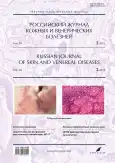Photogallery. Pathology of the oral mucosa in patients with HIV infection
- Authors: Prozherin S.V.1
-
Affiliations:
- Sverdlovsk Regional Center for Prevention and Control of AIDS
- Issue: Vol 28, No 2 (2025)
- Pages: 221-228
- Section: PHOTO GALLERY
- Submitted: 20.05.2024
- Accepted: 21.03.2025
- Published: 21.06.2025
- URL: https://rjsvd.com/1560-9588/article/view/632282
- DOI: https://doi.org/10.17816/dv632282
- EDN: https://elibrary.ru/TBMQPG
- ID: 632282
Cite item
Abstract
Lesions of the oral mucosa in people living with Human immunodeficiency virus (HIV) are characterized by a wide variety and high frequency of occurrence. According to some data, they are registered in half of HIV-positive individuals and in 80% of patients in the later stages of HIV infection. Publications on this topic report on more than twenty different types of diseases of the oral mucosa, most often diagnosed in HIV-infected individuals. Candidiasis is the earliest and most common secondary disease of HIV infection. While the spectrum of pathology has significant regional differences, candidiasis is the most common nosology on all continents. Diseases of the oral mucosa can be indicators of infection with the human immunodeficiency virus, early clinical symptoms of HIV infection, and also indicate its progression. The severity of lesions of the oral mucosa correlates with the level of immunosuppression: the lower the number of CD4+ T-lymphocytes, the more extensive the pathological process and the higher the relapse rate. Timely detection of diseases such as oral candidiases, hairy leukoplakia, Kaposi's sarcoma helps to establish the stage and phase of HIV infection in patients in accordance with the Russian clinical classification, and their regression or decrease in clinical manifestations indicates the effectiveness of antiretroviral therapy.
The photo gallery presents various diseases of the oral mucosa in HIV-positive patients, including lesions often associated with HIV infection (hairy leukoplakia, Kaposi's sarcoma, non-Hodgkin's lymphoma, case series of various clinical variants of candidiasis). From the archive of author's. The photographs are published for the first time.
Full Text
About the authors
Sergey V. Prozherin
Sverdlovsk Regional Center for Prevention and Control of AIDS
Author for correspondence.
Email: progsherin@mail.ru
ORCID iD: 0000-0001-9956-4700
SPIN-code: 5354-4893
Scopus Author ID: 57221442199
dermatovenereologist
Russian Federation, 46 Yasnaya st., 620102 YekaterinburgReferences
Supplementary files




















